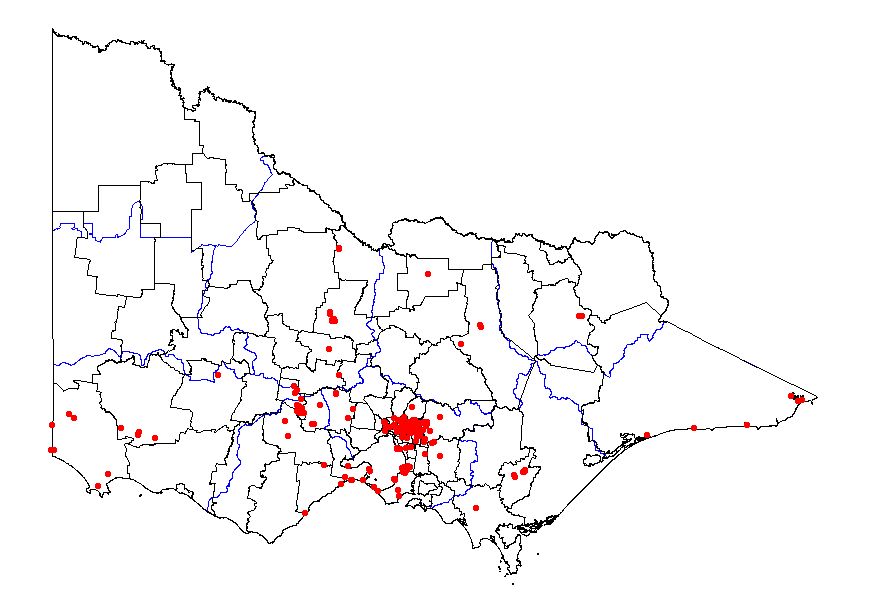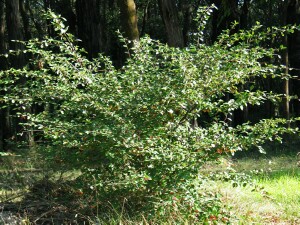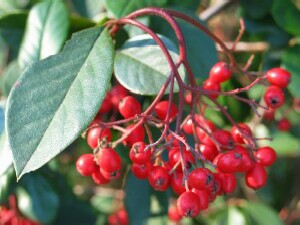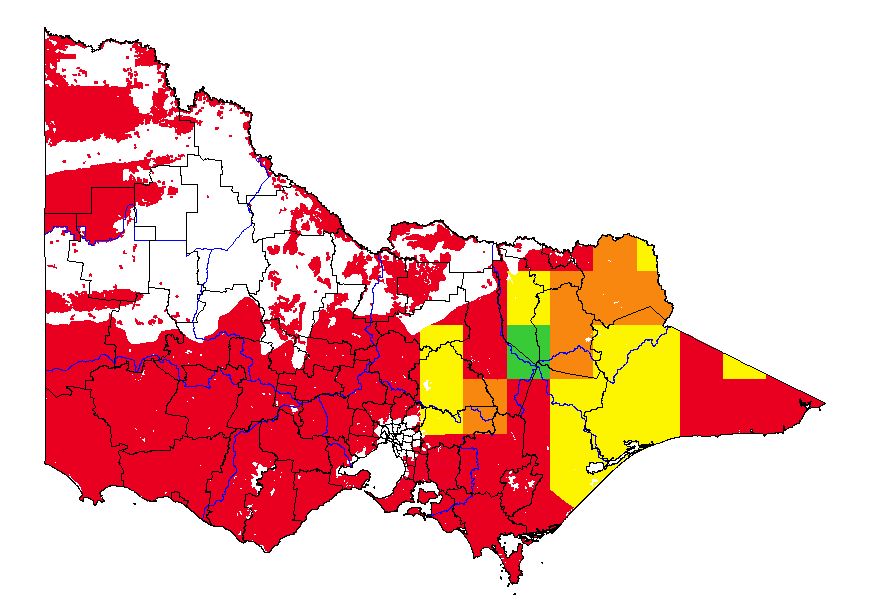Large Leaf Cotoneaster (Cotoneaster glaucophyllus)
Present distribution
|  Map showing the present distribution of this weed. | ||||
| Habitat: Reported to invade heathland, woodland both heathy and grassy, grassland, dry to wet sclerophyll forest, riparian vegetation, rocky outcrops and seasonal freshwater wetlands (Carr, Yugovic and Robinson 1992). | |||||
 Cotoneaster plant Photo: Mark Imhof |  Cotoneaster fruit Photo: Mark Imhof |
Potential distribution
Potential distribution produced from CLIMATE modelling refined by applying suitable landuse and vegetation type overlays with CMA boundaries
| Map Overlays Used Land Use: Forest private plantation; forest public plantation; horticulture; pasture dryland; pasture irrigation Broad vegetation types Coastal scrubs and grassland; grasslandCoastal scrubs and grassland; coastal grassy woodland; heathy woodland; lowland forest; heath; swamp scrub; box ironbark forest; inland slopes woodland; sedge rich woodland; dry foothills forest; moist foothills forest; montane dry woodland; montane moist forest; sub-alpine woodland; grassland; plains grassy woodland; valley grassy forest; herb-rich woodland; sub-alpine grassy woodland; montane grassy woodland; riverine grassy woodland; riparian forest; rainshadow woodland; mallee; mallee heath; mallee woodland; wimmera / mallee woodland Colours indicate possibility of Cotoneaster glaucophyllus infesting these areas. In the non-coloured areas the plant is unlikely to establish as the climate, soil or landuse is not presently suitable. | 
|
Impact
QUESTION | COMMENTS | RATING | CONFIDENCE |
| Social | |||
| 1. Restrict human access? | Has a dense growth habit, which helps the plant to form dense thickets (Weber 2003). Would require works to create access (Muyt 2001). | h | mh |
| 2. Reduce tourism? | Ornamental species may alter the aesthetics. | ml | l |
| 3. Injurious to people? | Cotoneaster berries are poisonous if consumed in large quantities (Shepherd 2004). In 1983-84 1.29% of the reports involving plants made to the Poisons centres in Australia involved a Cotoneaster species (Covacevich, Davie & Pearn 1987). | ml | mh |
| 4. Damage to cultural sites? | Ornamental species may alter the aesthetics. | ml | l |
| Abiotic | |||
| 5. Impact flow? | Terrestrial species | l | m |
| 6. Impact water quality? | Terrestrial species | l | m |
| 7. Increase soil erosion? | Cotoneaster species have been used for soil conservation in their native range (Singh, Bhagwati & Nawa 1992). | l | mh |
| 8. Reduce biomass? | Unknown; reported to form dense thickets, which could be an increase in biomass of the woodland that it has invaded, however can prevent the native shrubs and trees from regenerating (Weber 2003). Therefore in the short term biomass may increase, while in the long term a woodland or forest may become a shrubland. | m | mh |
| 9. Change fire regime? | Rated to have a moderate flammability (Chladil & Sheridan 2003). Has also been reported to from dense thickets (Weber 2003). Therefore an increase in the biomass of the shrub layer, with a moderate flammability, would be an increase of elevated fuels and therefore possibly a change to fire intensity. Able to re-shoot after low intensity fire (Muyt 2001). | ml | mh |
| Community Habitat | |||
| 10. Impact on composition (a) high value EVC | EVC= Grassy Woodland (E); CMA Corangamite; Bioreg Otway Ranges; VH CLIMATE potential. Can shade out other species and prevent native shrubs and trees regenerating (Weber 2003). Reported to form pure stands (Dept. Conservation, N.Z. 2002). | h | mh |
| (b) medium value EVC | EVC= Herb-rich Foothill Forest (D); CMA Corangamite; Bioreg Otway Ranges; VH CLIMATE potential. Can shade out other species and prevent native shrubs and trees regenerating (Weber 2003). Reported to form pure stands (Dept. Conservation, N.Z. 2002). | h | mh |
| (c) low value EVC | EVC= Riparian Forest (LC); CMA Corangamite; Bioreg Otway Ranges; VH CLIMATE potential. Can shade out other species and prevent native shrubs and trees regenerating (Weber 2003). Reported to form pure stands (Dept. Conservation, N.Z. 2002). | h | mh |
| 11. Impact on structure? | Can shade out other species and prevent native shrubs and trees regenerating (Weber 2003). Reported to form pure stands (Dept. Conservation, N.Z. 2002). | h | mh |
| 12. Effect on threatened flora? | Unknown, reported to shade out other species and prevent regeneration of native species (Weber 2003). | mh | l |
| Fauna | |||
| 13. Effect on threatened fauna? | Unknown | mh | l |
| 14. Effect on non-threatened fauna? | Alteration of habitat, reducing flora richness and creating dense thickets (Weber 2003). Therefore diversity in available food and shelter could be reduced. | mh | mh |
| 15. Benefits fauna? | Additional food source through berries for bird species (Muyt 2001). Dense shrubby vegetation, used for nesting sites by bird species (Lu, Zhang & Ren 2003). | m | mh |
| 16. Injurious to fauna? | Does have toxic properties, toxic to people (Shepherd 2004). However no detrimental effects to fauna reported, birds eat and disperse the berries (Muyt 2001). | l | m |
| Pest Animal | |||
| 17. Food source to pests? | Red berries attractive to frugivorous bird species, including blackbirds, seed also dispersed by foxes (Muyt 2001). Visited by bees (PFAF 2001). | mh | mh |
| 18. Provides harbor? | Cotoneaster species have been reported used as nesting sites by turtle-doves (Lu, Zhang & Ren 2003). Creates thickets (Weber 2003). Thickets may provide shelter for foxes and rabbits | m | m |
| Agriculture | |||
| 19. Impact yield? | Not an agricultural weed | l | m |
| 20. Impact quality? | Not an agricultural weed | l | m |
| 21. Affect land value? | Not an agricultural weed | l | m |
| 22. Change land use? | Not an agricultural weed | l | m |
| 23. Increase harvest costs? | Not an agricultural weed | l | m |
| 24. Disease host/vector? | Can be infected by fireblight (Blood 2001). Susceptible to honey fungus and the beet aphid (Jaskiewicz, Kmiec & Gantner 2004 and PFAF 2001). | h | mh |
Invasive
QUESTION | COMMENTS | RATING | CONFIDENCE |
| Establishment | |||
| 1. Germination requirements? | For propagation of cotoneaster species, seed is recommended to be sown in autumn, or stratified over winter and then sown under glass in spring (Griffths 1992). Therefore there is a seasonal component to the germination of cotoneaster species. | mh | mh |
| 2. Establishment requirements? | Will grow in shaded positions, however with increased shading reproductive capacity decreases (Muyt 2001). | mh | mh |
| 3. How much disturbance is required? | Reported to invade heathland (Blood 2001). | h | mh |
| Growth/Competitive | |||
| 4. Life form? | Shrub to small tree (Muyt 2001). | l | mh |
| 5. Allelopathic properties? | No reported for this species, however C. salicifolius has been reported to allelopathic potential (Morita, Ito & Harada 2005). | m | l |
| 6. Tolerates herb pressure? | Reported to be rarely eaten by deer (Simons 1996). Tolerant of pruning (PFAF 2001). | mh | mh |
| 7. Normal growth rate? | Reported to be fast growing (PFAF 2001). | mh | mh |
| 8. Stress tolerance to frost, drought, w/logg, sal. etc? | Tolerant of frost (Muyt 2001). Drought tolerant (Blood 2001). Tolerant of maritime exposure (PFAF 2001). Susceptible of waterlogging (PFAF 2001). Tolerant of low intensity fires, with the ability to coppice, more intense fire may kill the plant (Blood 2001). | mh | mh |
| Reproduction | |||
| 9. Reproductive system | Reproduces sexually, producing seed (Weber 2003). Cotoneaster species are capable of layering, where branches that are in constant contact with the ground can set root (Bossard, Randell & Hoshovsky 2000). | h | mh |
| 10. Number of propagules produced? | Mature plants can produce thousands of fruits (Muyt 2001). Each fruit contains 2 seeds (Shepherd 2004). | h | mh |
| 11. Propagule longevity? | Due to the seeds germinating after a 14 month stratification study on C. horizontalis, seed viability was at 38% (Blomme & Degeyter 1985). Unknown however how long a seed can remain viable. | m | l |
| 12. Reproductive period? | Able to form monocultures (Dept of Conservation, N.Z 2002) | h | mh |
| 13. Time to reproductive maturity? | Unknown, large shrub could presume 2-5 years. | m | l |
| Dispersal | |||
| 14. Number of mechanisms? | Produces red berries, which are then dispersed by birds and animals (Muyt 2001). | h | mh |
| 15. How far do they disperse? | Birds and animals can disperse fruit seeds distances greater than 1km (Spennemann & Allen 2000). | h | mh |
References
Blomme R. & Degeyter L., 1985, Seed treatments and germination determinations for seeds of Cotoneaster horizontalis. Verbondsnieuws voor de Belgische Sierteelt. 29: 17-23
Blood K., 2001, Environmental Weeds. A field guide for SE Austalia. CH Jerram & Associates – Science publishers. Mt Waverly.
Bossard C.C., Randell J.M. & Hoshovsky M.C., 2000, Invasive plants of California’s wildlands. University of California Press.
Carr G.W., Yugovic J.V. and Robinson K.E.,, 1992, Environmental weed invasions in Victoria: conservation and management implications, Department of Conservation and Environment, Clifton Hill.
Chladil M. & Sheridan J., 2003, Fire Retardant Garden Plants for the Urban Fringe and Rural Areas. Tasmainan Fire Research Fund and the Royal Tasmanian Botanical Gardens.
Covacevich J., Davie P. & Pearn J., 1987, Toxic plants & animals. A guide for Australia. Queensland Museum. Brisbane
Department of Conservation, Wellington Conservancy, New Zealand, 2002, Plant me instead: plants to use in place of common and invasive environmental weeds in the lower North Island. Department of Conservation, Wellington Conservancy, New Zealand
Griffths M., 1992, The new Royal Horticultural Society dictionary of gardening. Macmillan. London
Jaskiewicz B., Kmiec K. & Gantner M., 2004, Beet aphid and ornamental shrubs. Ochrona Roslin. 49: 30-32
Lu X., Zhang L.Y., & Ren C., 2003, Breeding ecology of the rufous turtle dove (Streptopelia orientalis) in mountain scrub vegetation, Lhasa (Tibet). Game & Wildlife Science. 20: 225-240
Morita S., Ito M. & Harada J., 2005, Screening of an allelopathic potential in arbor species. Weed Biology and Management. 5: 26-30
Muyt A., 2001, Bush invaders of south-east Australia: a guide to the identification and control of environmental weeds in south-east Australia, R.G. and F.J. Richardson, Collingwood.
PFAF: Plants for a Future. Edible, medicinal and useful plants for a healthier world. viewed 6 Jul 2001, http://pfaf.org/
Shepherd R.C.H., 2004, Pretty but poisonous. Plants poisonous to people, an Illustrated Guide for Australia. R.G. and F.J. Richardson. Meredith
Singh R.P., Bhagwati P. & Nawa B., 1992, Cotoneaster microphylla Wall. – suitable for soil conservation in temperate regions of Himalayas. Indian Forester. 118: 672-675
Spennemann. D.H.R. & Allen. L.R., 2000, Feral olives (Oliea europaea) as future woody weeds in Australia: a review. Australian Journal of Experimental Agriculture. 40: 889-901.
Weber, E. 2003, Invasive plant species of the world: a reference guide to environmental weeds, CABI Publishing, Wallingford.
Global present distribution data references
Australian National Herbarium (ANH) 2006, Australia’s Virtual Herbarium, Australian National Herbarium, Centre for Plant Diversity and Research, viewed 4 Dec 2006 , http://www.anbg.gov.au/avh/
EIS: Environmental Information System 2006. Parks Victoria.
FIS: Flora Information System 2005. Department of Sustainability and Environment.
Global Biodiversity Information Facility (GBIF) 2006, Global biodiversity information facility: Prototype data portal, viewed 1 Dec 2006, http://www.gbif.org/
IPMS: Integrated Pest Management System 2006. Department of Primary Industries.
Missouri Botanical Gardens (MBG) 2006, w3TROPICOS, Missouri Botanical Gardens Database, viewed 1 Dec 2006, http://mobot.mobot.org/W3T/Search/vast.html
Feedback
Do you have additional information about this plant that will improve the quality of the assessment?
If so, we would value your contribution. Click on the link to go to the feedback form.


